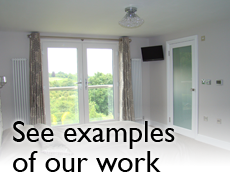Loft Conversion Requirements
To be able to convert your loft, there needs to be at least 2.3 meters from the top of the celling joist to the underneath of the ridge board in your roof. If your existing roof structure has sufficient height, there will be several different ways in which your loft can be converted, depending on the shape of your house, building regulations and planning permission.
If there isn’t the sufficient height between the ridge board and the ceiling joists. Then with planning approval you may, be able to raise the ridge of your roof if your house is detached, then the roof could be pitched steeper when building the loft conversion this would then gain the head room needed. If it is not possible to raise the ridge height then the existing celling’s could be lowered to gain the head room.
If you have the requirements to be able to convert your loft, you will need to start considering the following:
Planning Permission
Basic information you should know about planning permission when building a loft conversion
Read more >
What is Planning Permission?
In the UK the planning system is designed to retain UK heritage whilst allowing the development of homes, towns, cities and countryside.
The Planning permission for home improvements is governed by your Local Authority.
Who gains planning permission?
Oakleaf Lofts can help in the process of gaining planning permission, although if you have your own Architect, he/she would normally gain permission on your behalf.
If your property requires planning permission, it is your responsibility to ensure that planning permission is obtained before work is carried out.
Do I need Planning permission?
Not necessarily. If your home falls under ‘Permitted Development’, you may not need to gain planning permission. If in doubt always check with your Local Authority.
What if I live in a conservation area or a grade 1, 2 or 2* property?
You will be subject to further conditions which will be laid out by your Local Authorities planning department.
How long will it take?
Typically around 8 weeks. 8 weeks is the time allowance set out by central government for local authorities to make a decision.
If your application is considered complex, the time allowance rises to 13 weeks.
In our experience some Local Authorities may take longer to process your application during busy periods.
What will I need to consider?
- Survey and Drawings- You should have your home surveyed and accurate drawings made of the proposed changes
- Design Access Statement- This is a statement that needs to submitted within your application that demonstrates your understanding of the layout; proportions; volume; materials and impact of your proposal
- Time- allow 4- 10 weeks (approx.) for this process as you will be involved in making decisions relating to the design that you may be living with for some time.
- Neighbours
In total, from initial survey/design to gaining a decision on your application for planning, you should allow for three months plus.
All of the above is normally carried out by your architect and is a service that Oakleaf Lofts offer as part of the Loft Conversion process.
What if Planning is rejected?
If you submit an application for planning permission and the application is rejected, your Local Authority will provide you with the reasons for refusal. Normally these conditions can be met with a few adjustments to the design. Speak to your Architect about any proposed changes. If you and your architect are happy with the changes and they address the conditions you have been asked to fulfil, the application, along with new drawings can be submitted.
More info
For more information about planning permission in your area, please contact your Local Authority.
Permitted Development
Some buildings do not require planning permission in order to qualify for a loft conversion.
Read more >Some properties fall under permitted development (PD). This means you do not need to apply for planning permission.
Normally if your development gains under a particular cubic volume of additional space, related to your type of property, you can bypass the planning process.
Criteria of PD in relation to loft conversions
- The development must not exceed 40 cubic metres of additional volume to a terraced property
- The development must not exceed 50 cubic metres of additional volume to a semi-detached/detached property
- No conversion can exceed the height of the highest point of the existing roof
- Dormers and roof windows can be added but must not extend beyond the plane of the roof slope at the front of the property.
If your property falls under PD but is subject to further requirements, you may need to apply for a lawful development certificate (LDC)
LDC is a formal application to Local Authority to decide if PD or Planning Permission is required.
The document can also be used as a formal document proving that the development is legal under permitted development (although it is not always needed).
Building Regulations
Information on building standards and regulations surrounding loft conversions
Read more >What are Building Regulations / Building Control?
Building regulations exist to ensure the health and safety, welfare and convenience of people in and around buildings. The main function of building control is to ensure compliance with building regulations.
Party Wall Act 1996 (in relation to Loft Conversions)
This legislation covers the erection of structures that will affect a wall that is shared with your neighbours’ structure.
It is advisable to contact your neighbours, as early as possible I a non-formal way to explain your proposed plans.
When converting a semi-detached or terraced property the Party Wall Act comes into force. The act requires that you give your neighbour prior notice, and your neighbour will need to sign the relevant documents (Oakleaf Lofts can provide this).
Although your neighbour cannot stop work going ahead, they can object or dispute the work intended. This can lead to disruptions to the build as you will be required to hire a surveyor to ensure the work carried out is of a suitable standard. The surveyor will dictate a schedule of conditions to be met, that suits both parties and will return towards the end of the build to ensure these have been carried out.
Whose responsibility is it to ensure Building Regulations are met?
Oakleaf lofts takes building regulations very seriously. It is our responsibility to ensure all of our work is fully compliant with building regulations and is passed by building control. At Oakleaf lofts the safety of yourselves and your family is of paramount importance to us.
The following fire safety regulations are fully adhered to as standard:
- There is a viable means of escape
- The installation of smoke detectors
- Internal fire spread prevention (i.e. internal fire doors fitted)
- External fire spread prevention (i.e. fire resistant materials used on exterior dormers etc.)
New staircases:
There should be a minimum of 2 meters head room at the top of your staircase. The rise and going of each tread and the pitch of the staircase must comply with building regulations.
All our staircases are designed to meet these regulations and we will consult with staircase specialists to ensure regulations are met prior to installation.
Insulation and Airflow
Building regulations require all loft conversions to have adequate insulation to avoid heat loss and cold spots (known as the 'U' Value). We will ensure your loft is well ventilated to avoid condensation and improve airflow as well as fully insulate your new conversion to meet building regulations standards.


